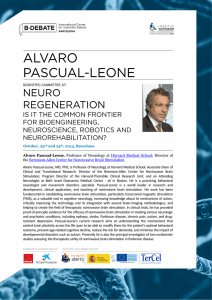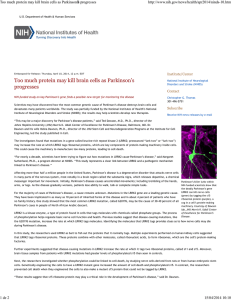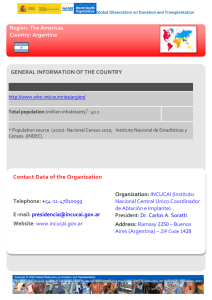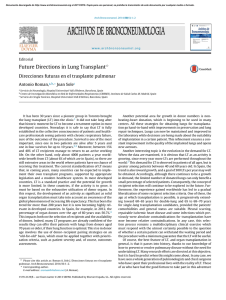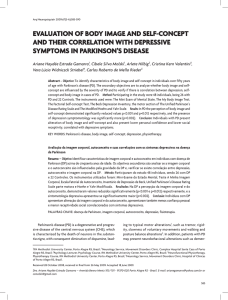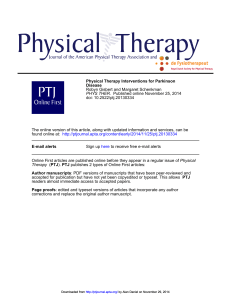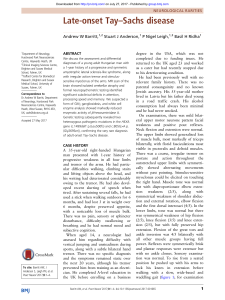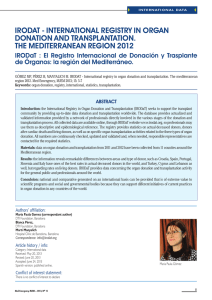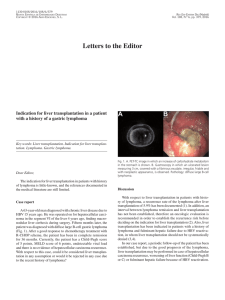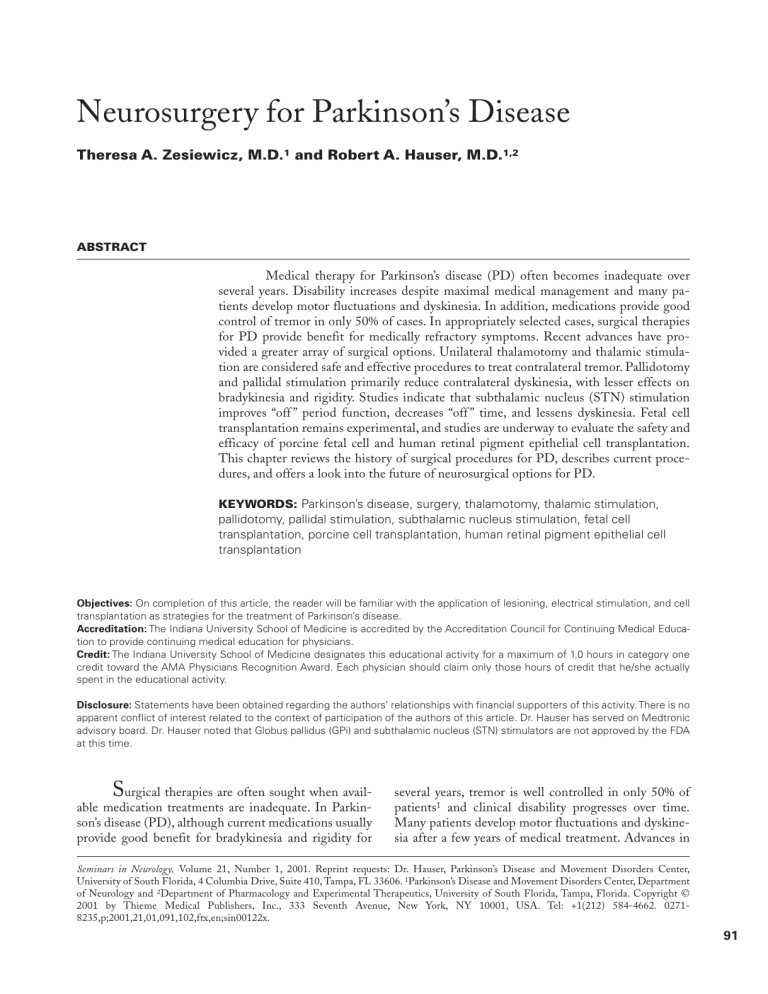
Neurosurgery for Parkinson’s Disease Theresa A. Zesiewicz, M.D.1 and Robert A. Hauser, M.D.1,2 ABSTRACT Medical therapy for Parkinson’s disease (PD) often becomes inadequate over several years. Disability increases despite maximal medical management and many patients develop motor fluctuations and dyskinesia. In addition, medications provide good control of tremor in only 50% of cases. In appropriately selected cases, surgical therapies for PD provide benefit for medically refractory symptoms. Recent advances have provided a greater array of surgical options. Unilateral thalamotomy and thalamic stimulation are considered safe and effective procedures to treat contralateral tremor. Pallidotomy and pallidal stimulation primarily reduce contralateral dyskinesia, with lesser effects on bradykinesia and rigidity. Studies indicate that subthalamic nucleus (STN) stimulation improves “off ” period function, decreases “off ” time, and lessens dyskinesia. Fetal cell transplantation remains experimental, and studies are underway to evaluate the safety and efficacy of porcine fetal cell and human retinal pigment epithelial cell transplantation. This chapter reviews the history of surgical procedures for PD, describes current procedures, and offers a look into the future of neurosurgical options for PD. KEYWORDS: Parkinson’s disease, surgery, thalamotomy, thalamic stimulation, pallidotomy, pallidal stimulation, subthalamic nucleus stimulation, fetal cell transplantation, porcine cell transplantation, human retinal pigment epithelial cell transplantation Objectives: On completion of this article, the reader will be familiar with the application of lesioning, electrical stimulation, and cell transplantation as strategies for the treatment of Parkinson’s disease. Accreditation: The Indiana University School of Medicine is accredited by the Accreditation Council for Continuing Medical Education to provide continuing medical education for physicians. Credit: The Indiana University School of Medicine designates this educational activity for a maximum of 1.0 hours in category one credit toward the AMA Physicians Recognition Award. Each physician should claim only those hours of credit that he/she actually spent in the educational activity. Disclosure: Statements have been obtained regarding the authors’ relationships with financial supporters of this activity. There is no apparent conflict of interest related to the context of participation of the authors of this article. Dr. Hauser has served on Medtronic advisory board. Dr. Hauser noted that Globus pallidus (GPi) and subthalamic nucleus (STN) stimulators are not approved by the FDA at this time. S urgical therapies are often sought when available medication treatments are inadequate. In Parkinson’s disease (PD), although current medications usually provide good benefit for bradykinesia and rigidity for several years, tremor is well controlled in only 50% of patients1 and clinical disability progresses over time. Many patients develop motor fluctuations and dyskinesia after a few years of medical treatment. Advances in Seminars in Neurology, Volume 21, Number 1, 2001. Reprint requests: Dr. Hauser, Parkinson’s Disease and Movement Disorders Center, University of South Florida, 4 Columbia Drive, Suite 410, Tampa, FL 33606. 1Parkinson’s Disease and Movement Disorders Center, Department of Neurology and 2Department of Pharmacology and Experimental Therapeutics, University of South Florida, Tampa, Florida. Copyright © 2001 by Thieme Medical Publishers, Inc., 333 Seventh Avenue, New York, NY 10001, USA. Tel: +1(212) 584-4662. 02718235,p;2001,21,01,091,102,ftx,en;sin00122x. 91 92 SEMINARS IN NEUROLOGY/VOLUME 21, NUMBER 1 2001 our knowledge of the anatomy and physiology of the extrapyramidal motor circuits coupled with the development of more sophisticated neuroimaging and surgical techniques have renewed interest in neurosurgical treatments for PD.2 Surgical procedures currently fall into three categories: lesioning, chronic electrical stimulation, and cell transplantation. This article reviews the history of neurosurgical procedures for PD, evaluates current procedures, and offers a look into the future. HISTORY Major limitations in medical therapy for both PD and postencephalitic parkinsonism3 sparked interest in surgical treatments in the 1930s and 1940s. Early neurosurgical procedures focused on pyramidal tract lesions for tremor resolution, but tremor reduction came only at the expense of motor weakness. The era of basal ganglia surgery for PD began when Meyers4,5 first noted that ablation of pallidofugal fibers originating from the medial globus pallidus improved tremor and rigidity. Unfortunately, the resultant reduction of symptoms was often accompanied by neurologic deficits.6 In 1952, Irving S. Cooper inadvertently nicked and then ligated the anterior choroidal artery during a cerebral pedunculotomy for postencephalitic parkinsonism. The patient experienced a reduction in tremor and rigidity without residual hemiparesis. Cooper concluded that symptom improvement was due to infarction of the anterior and lateral portions of the thalamus, the regions perfused by the anterior choroidal artery. He proceeded to perform anterior choroidal artery occlusion on approximately 50 patients, noting that 65% experienced improvement in tremor, rigidity, bradykinesia, and gait abnormalities.3,7,8 However, the operative mortality rate was approximately 10%. Pallidotomy became a popular surgical procedure in the 1950s. It was found that lesioning the posteroventral rather than the anterodorsal pallidum resulted in more satisfactory tremor suppression.9 Thalamotomy eventually replaced pallidotomy as the treatment of choice because of more consistent benefit in tremor reduction and lower rates of tremor recurrence.9–12 However, side effects of thalamotomy included motor deficits and dystonia, and bilateral thalamotomy often resulted in dysarthria and neuropsychiatric complications.13 Neurosurgical techniques were rarely performed following the introduction of levodopa therapy in the late 1960s. However, interest in surgical procedures for PD was rekindled in the 1970s, when the limitations of levodopa therapy became apparent. TYPES OF SURGERY Surgical options to treat PD include lesioning, stimulation, and implantation. Lesioning, or “ablation,” con- sists of anatomical destruction of a target by electrical energy. Chronic stimulation involves placing an electrode into a target site. A wire beneath the skin connects the electrode to a stimulator placed in the chest wall. The stimulator is adjusted by external means to optimize symptom control and minimize side effects. Chronic stimulation has the advantage of adjustability and reversibility. Side effects of stimulation can be resolved by adjustment or discontinuation of stimulation. If stimulation fails to provide benefit, the hardware can be removed. Implantation of cells into a target site attempts to replace neurons that have died from the disease process. STEREOTACTIC SURGERY Stereotactic procedures employ a grid-coordinate system to target brain locations. First introduced in the 1940s, stereotactic techniques have significantly reduced postoperative morbidity and mortality in PD. Spiegel et al14 placed a ring fixed to a plaster of Paris cap on the heads of patients and used pneumoencephalography to outline the lateral ventricles to define the location of brain targets. They lesioned the ansa lenticularis of four PD patients and noted improvement in rigidity and tremor without weakness.15 Svennilson et al also utilized stereotactic lesioning of the posteroventral rather than the anterodorsal thalamus with good results.9 Laitenen et al16,17 reintroduced stereotactic surgery in the 1980s, reporting results of 38 pallidotomies performed on hypokinetic PD patients. At 28 months after surgery, 92% of patients exhibited significant improvement in hypokinesia and rigidity. Eighty-one percent of patients reported reduction in tremor. Six patients suffered permanent partial homonymous hemianopsia, and one patient experienced transient postoperative hemiparesis. Advances in neuroimaging have permitted more precise target localization using magnetic resonance imaging (MRI) and computerized localization. However, even these systems have limitations. There may be individual variation of functional anatomy within MRIdefined structures, and there may be brain shift from the time of imaging. Electrophysiologic techniques, including microelectrode recording, help further define target location during surgery. Pathophysiology In PD, there is increased inhibitory output from the internal segment of the globus pallidus (GPi) to thalamocortical neurons, thereby decreasing cortical motor output (Fig. 1). This is expressed clinically as bradykinesia. The striatal dopamine deficiency in PD causes underactivity of the direct pathway (which is inhibitory) and overactivity of the indirect pathway (which is excita- NEUROSURGERY FOR PARKINSON’S DISEASE/ZESIEWICZ, HAUSER Figure 1 Decreased dopamine production by the SNc leads to overinhibition of the thalamocortical pathway. tory) to the GPi. This leads to increased inhibitory output from the GPi to the thalamus. This model suggests that lesioning of the subthalamic nucleus (STN) or GPi should diminish the excessive inhibitory output from the GPi and improve bradykinesia. The pallidum is a target for lesioning or chronic stimulation (which has a functional effect similar to that of lesioning), whereas the STN is mostly a target for stimulation because of concern that lesioning might cause uncontrolled dyskinesia similar to chorea seen following an STN infarction. Cell transplantation aims to correct the striatal dopamine deficiency, thereby normalizing basal ganglia function. THALAMOTOMY Thalamotomy effectively reduces contralateral tremor in PD and, to a lesser extent, rigidity. Long-term experience with thalamotomy indicates that the procedure improves contralateral tremor in roughly 45.8 to 92% of cases, while rigidity is significantly reduced in 41 to 92%.18–27 Studies have documented good tremor reduction in approximately 80% of patients.28 Linhares and Tasker29 performed 40 microelectrode-guided thalamotomies in PD patients and reported upper limb tremor reduction in 75% of patients at a mean of 35.8 months. Persistent hand ataxia occurred in 12.5%, and gait disturbances and paresthesias were reported in 7.5% and 27.5%, respectively. Fox et al30 performed 36 ventrolateral thalamotomies using microelectrode recording and reported persistent tremor abolition in 86% and improvement in an additional 5%. Osenbach and Burchiel31 performed unilateral ventral intermediate (VIM) nucleus thalamotomies without microelectrode recording in 57 PD patients and reported complete tremor relief in 79%. Successful thalamotomies produce long-term tremor suppression. Diedrich et al32 evaluated 17 pa- tients a mean of 10.9 years after thalamotomy. The amplitude of the tremor contralateral to surgery was significantly less than that on the ipsilateral side, indicating persistence of benefit.32 Moriyama et al33 noted significant reduction of contralateral tremor and rigidity at a mean of 8.8 years in 44 patients who underwent unilateral thalamotomy. Thalamotomy-associated mortality is less than 1% and usually due to hemorrhage at the lesion site.27 Transient paresthesias of the fingers or mouth occur commonly but usually resolve within 1 year of surgery.19,27 Less than 1.3% of patients experience seizures. Historically, weakness occurred in up to 26% of patients, but it is now rare with modern techniques.21,22,24–27,34 Bilateral thalamotomies are associated with a high incidence of dysarthria and swallowing difficulties13,27 and are now rarely performed. If a second thalamic surgery is required, chronic stimulation is the procedure of choice to minimize the likelihood of permanent sequelae. PALLIDOTOMY Pallidotomy refers to lesioning of the globus pallidus interna (Gpi). Originally popular in the prelevodopa era (1950s and 1960s), pallidotomy was largely replaced by thalamotomy because this procedure more consistently improved tremor. Pallidotomy was resurrected by Laitenen in the 1980s. A better understanding of the anatomy of the basal ganglia motor circuit, advances in stereotactic techniques, and improved neuroimaging led to a resurgence of the procedure in the 1990s.35 Pallidotomy is very effective in reducing contralateral dyskinesias and, to a much lesser extent, contralateral offperiod symptoms.3 Based on discussions with Leksell, Laitenen et al37 performed posteroventral pallidotomies and reported significant improvement in tremor, rigidity, bradykinesia, gait, speech, and dyskinesia in 38 patients. Dogali et al38 reported results of stereotactic pallidotomy using microelectrode recording in 18 patients with severe motor fluctuations. Resolution of contralateral dyskinesia and improvement in bradykinesia, rigidity, and tremor were noted. Patients were able to take more levodopa in light of diminished dyskinesia. At 12 months, off-period Unified Parkinson’s Disease Rating Scale (UPDRS) motor scores were improved by 65%, and timed tests of motor function improved 38.2% in the contralateral limb and 24.2% in the ipsilateral limb. Less striking improvements were also reported during on-periods. Lozano et al,39 using blinded evaluations 6 months after pallidotomy, found total “off ” motor scores improved by 30% while dyskinesias were practically eliminated. Contralateral tremor was also significantly improved. Baron et al40 evaluated 15 advanced 93 94 SEMINARS IN NEUROLOGY/VOLUME 21, NUMBER 1 2001 patients and found significant improvement in off-period motor UPDRS scores at 3 months (24.9%). Onperiod scores were only transiently improved. Uitti et al41 noted significant improvement in both on and off UPDRS motor scores in 20 PD patients after pallidotomy. Mean on UPDRS motor scores improved by 24%, and mean UPDRS off motor scores were reduced by 20%. Lang et al36 followed advanced PD patients for up to 2 years following posteroventral medial pallidotomy and found significant reductions in contralateral dyskinesias, bradykinesia, rigidity, and off-period parkinsonism. Total activities of daily living (ADLs) and motor off UPDRS scores improved by about 30% at 6 months following surgery, with benefit sustained at 2 years.36 On-period dyskinesia in this series improved by more than 80% contralateral to the lesion and remained improved at 2 years following surgery. Improvements were noted in ipsilateral symptoms within the first year after surgery but did not persist. A number of additional series have been reported with similar results.42,43 Pallidotomy improves bradykinesia as measured by movement and reaction time. Jankovic et al44 evaluated the effect of unilateral, microelectrode-guided posteroventral pallidotomy on bradykinesia in 41 moderately advanced PD patients. At 3 months, movement time (MT) improved by 24% on the contralateral side (P < .0001) and by 12% on the ipsilateral side (P < .005). On the contralateral side, simple reaction time (SRT) improved 14.5% (P < .001) and choice reaction time (CRT) improved by 12.2% (P < .001). Purdue pegboard (PP) scores improved by 35.5% (P < .0002) in the contralateral arm but significant improvement did not occur in the ipsilateral arm.44 Although at least three studies have noted improvement in postural instability following pallidotomy,16,38,45 several other studies have reported that balance remains unchanged.39,40,46–48 One open-label study of 29 PD patients 3 and 6 months after pallidotomy failed to note a change in postural instability as measured by UPDRS, although 9 patients (56%) who were able to stand prior to surgery had an improvement in the average stability score or a decrease in the number of falls after surgery.49 At least one open-label study also suggests that pallidotomy significantly improves quality of life in patients with advanced PD.50 Martinez-Martin et al reported that four areas of the PDQ-3939 (mobility, ADLs, emotions, and bodily pain) were significantly improved following pallidotomy (P < .01 to .001). Several studies have identified greater improvement in younger patients than older patients.40,46,51 Lang et al,46 for example, noted 36% improvement in patients 60 years or younger and only 16% in patients older than 60 years. Baron et al40 found that total UPDRS scores improved by 52% in patients aged 38–52 years, whereas patients aged 58–69 had only a 14% improvement. Similarly, Kishore et al46,52 found a correlation between age and improvement in off motor scores in patients who received pallidotomy. However, Uitti et al41 reported that older patients responded as well as younger patients. Because the optic tract and internal capsule lie in close proximity to the globus pallidus, potential complications from pallidotomy include visual field deficits and hemiparesis. Additional potential adverse effects from pallidotomy include hemorrhage, dysarthria, postoperative confusion, dysphagia, facial droop, and somnolence.46,53 Weight gain following unilateral pallidotomy in PD has also been reported. In one open-label series, postpallidotomy patients were found to have gained a mean of 4.0 4.1 kg 1 year after surgery.54 Improvement in off motor scores (P < .005) and on motor scores (P < .05) predicted weight gain. BILATERAL PALLIDOTOMY There is little information available regarding bilateral pallidotomy.55,56 One study found that bilateral pallidotomy significantly reduced dyskinesia.57 Another case series evaluating gait 1 month prior to and 1 month following bilateral pallidotomy identified a twofold increase in walking speed.50 However, bilateral pallidotomy is associated with an increased risk of complications including cognitive and bulbar symptoms, especially dysarthria and swallowing difficulties.58,59 DEEP BRAIN STIMULATION Deep brain stimulation (DBS) was developed in the 1970s as a nonablative procedure.60–62 During DBS surgery, an electrode is implanted into the target and attached by wire to a programmable stimulator placed under the skin in the chest wall. Targets of DBS for PD include the VIM nucleus of the thalamus, the internal segment of the globus pallidus (GPi), and the subthalamic nucleus (STN). The clinical effects of chronic high-frequency stimulation mimic a lesion. Once implanted, the stimulator is adjusted externally using a programmer with an electromagnetic head to optimize clinical response and minimize side effects. Patients may turn the stimulator on and off themselves using a handheld magnet. THALAMIC STIMULATION The main effect of thalamic DBS is to reduce contralateral tremor. Like thalamotomy, stimulation of the VIM nucleus of the thalamus suppresses tremor,30,63 but it offers the additional advantage that stimulation is ad- NEUROSURGERY FOR PARKINSON’S DISEASE/ZESIEWICZ, HAUSER justable. Benabid et al64 followed 80 PD patients who underwent chronic thalamic stimulation and found that upper extremity tremor was completely or almost completely controlled in 92% of patients at 3-month followup and that in many cases the procedure’s effects lasted up to 8 years. Lower extremity tremor was also effectively reduced. The most commonly reported side effect was paresthesias at high stimulation intensities. Benabid et al64 noted that resting and postural tremors were more frequently improved by VIM stimulation than action tremors. In another early study, Blond et al65 followed 10 PD patients who underwent VIM stimulation and noted tremor suppression or reduction in all cases. Koller et al66 performed a multicenter trial to determine the safety and efficacy of unilateral, highfrequency VIM stimulation in 24 PD patients with tremor. Patients underwent blinded evaluations 3 months after DBS, randomly assigned to stimulation on or off. Additional open-label evaluations were conducted at 6, 9, and 12 months. VIM stimulation resulted in a significant decrease in contralateral tremor with stimulation on at all visits. Fourteen of the 24 patients (58.3%) had complete tremor resolution, and only 1 patient (4.2%) experienced no benefit. Six patients were not implanted. Reasons for not implanting included lack of tremor suppression at surgery (two patients), intracranial hemorrhage (one patient), microthalamotomy effect (one patient), subdural hemorrhage during burr hole placement (one patient), and withdrawal of consent in the operating room (one patient). Complications related to surgery included lead dislodgment during surgery (one patient), ischemic changes on electrocardiogram (one patient), and generalized motor seizure postoperatively (one patient). Common side effects included transient paresthesias in 42 patients (79.2%) at 3 months, 19 patients (35.8%) at 6 months, and 11 patients (20.8%) at 12-month follow-up. Headache occurred in six patients (11.3%), and five patients (9.4%) experienced disequilibrium 3 months after surgery. Seventy-three PD patients who received thalamic stimulation were followed in a multicenter European study.67 At 3- and 12-month follow-up, upper and lower extremity tremor was significantly reduced (P < .001). Stimulation significantly improved UPDRS motor scores, contralateral akinesia, and rigidity at 3- and 12-month follow-up. Ondo et al68 evaluated 19 PD patients who received unilateral thalamic DBS. PD patients demonstrated a significant reduction in contralateral tremor (P < .0001), subjective tremor scores (P < .0001), and disability scores (P < .01). Adverse events were mild and responded to parameter adjustment. Most side effects of thalamic DBS are mild, and resolve with cessation of stimulation. In one large case series, side effects included paresthesias (9%), dysarthria (19.6%), disequilibrium (9%), and dystonia (5%).64 Of bilaterally stimulated patients, 27.5% experienced dysarthria, compared with 40% of patients who underwent unilateral thalamotomy with stimulation on the opposite side. Bilaterally stimulated patients also did not experience the neuropsychological deficits seen commonly with bilateral thalamotomy. Thalamotomy and thalamic stimulation appear to provide comparable efficacy to reduce contralateral tremor. Advantages of thalamic DBS over thalamotomy include reversibility of the procedure (the electrode can be explanted) and adjustability of stimulation parameters (to maximize symptom control and minimize side effects related to stimulation).69 Disadvantages of chronic stimulation include expense, potential hardware malfunction, battery replacement every several years, and, potentially, a higher infection rate. PALLIDAL STIMULATION Chronic high-frequency stimulation of the GPi has been shown to improve off symptoms, dyskinesias, and motor fluctuations in a limited number of studies. Siegfried and Lippitz70 first reported improvement in three PD patients who underwent bilateral pallidal stimulation. Volkman et al71 performed an open-label prospective study in nine advanced PD patients who underwent bilateral stimulation of the internal pallidum. UPDRS motor scores were significantly reduced at 3-month follow-up, from 54.1 14.8 to 23.9 11.7 (44.2%) when stimulation was turned on. Improvements were noted in tremor, rigidity, bradykinesia, gait, posture, and dyskinesia. There was no decline in clinical effectiveness at 12-month follow-up (n = 4). Long-term efficacy of the procedure is not well defined. Ghika et al72 followed six advanced PD patients who received bilateral pallidal stimulation for a period of at least 24 months. Improvements were noted in UPDRS ADL, motor, and total off scores (>50%), mean off time (>50%), and dyskinesia (65%). Four of the six patients had no perceptible motor fluctuations and two other patients experienced only very mild motor fluctuations. However, there was a trend toward loss of clinical efficacy at 1 year despite stimulation parameter adjustments. Side effects included dysarthria, dystonia, and confusion. Three patients reported gait ignition failure at 1 year, and this was their most troublesome deficit. SUBTHALAMIC NUCLEUS STIMULATION The STN contains glutaminergic, excitatory output projections to the external and internal segments of the globus pallidus, substantia nigra pars reticulata (SNr), and substantia nigra pars compacta (SNc).73,74 Dopamine deficiency in PD causes overactivity of the STN, and lesions in this region improve parkinsonian signs in 95 96 SEMINARS IN NEUROLOGY/VOLUME 21, NUMBER 1 2001 humans.75 It has also been hypothesized that STN projection burst firing in the SNc may lead to excitotoxic damage,76 and therefore strategies that reduce STN overactivity might provide neuroprotection. STN stimulation has been shown to improve symptoms of PD dramatically, particularly off-period akinesia and rigidity. Limousin et al77 evaluated 24 PD patients who received bilateral STN stimulation for 12 months and found that off-medication UPDRS ADLs and motor scores improved 60% (P < .001), while levodopa dosage was decreased by 50%. Krack et al78 followed 15 PD patients with tremor who received STN stimulation and reported a reduction of 80% in UPDRS tremor score and a 65% reduction in rigidity 1 to 12 months following surgery. Transient side effects included postoperative confusion, lower limb thrombophlebitis, seizures, and stimulation-induced dyskinesias that resolved with adjustment of stimulation parameters. Houeto et al79 prospectively followed 23 advanced PD patients who received bilateral STN stimulation for 6 months. UPDRS ADLs improved by 66% (30 3 to 10 2; P < .001) in the off state and 55% (11 2 to 5 1; P = .01) in the on state. Hoehn and Yahr motor disability score in the off state decreased by 58% (P <.001), and motor fluctuation severity decreased by 78% (P <.001). The daily dose of antiparkinsonian medication was reduced by 61% (P < .001) and dyskinesias improved by 77% (P < .001). No significant adverse events occurred in this cohort. Three patients experienced a confusional state after surgery that resolved within 1 day. Transient side effects related to stimulation were common, including chorea, ballismus, and dystonia, and improved with refinement of stimulation settings. Moro et al80 followed seven advanced PD patients who received bilateral STN stimulation for an average of 16.3 7.6 months and reported significant improvements in rigidity, tremor, and bradykinesia. Off-medication UPDRS motor scores improved by 41.9% at the last visit (P = .0002), and UPDRS ADLs improved by 52.2% (P = .0002). Levodopa-equivalent daily dose was decreased by 65%. Common side effects included ballistic or choreic movements. Krack et al81 followed eight advanced PD patients who received STN stimulation and suffered from severe off-period dystonia. Six months postoperatively, patient-reported pain in off-periods decreased by 66% (from 3.8 1.3 to 1.3 0.9, P < .05). The severity of off-period dystonia was also reduced by 90% at 6-month follow-up. Duration of on-period dyskinesias decreased by 52% (from 2.3 0.9 to 1.1 0.4; P < .05). Kumar et al82 compared the clinical effects of unilateral and bilateral STN stimulation in 10 advanced PD patients and reported that bilateral STN stimulation resulted in a greater reduction of parkin- sonism. Bilateral STN stimulation improved parkinsonian symptoms by 54%, while unilateral stimulation improved symptoms by 23%. Bilateral STN stimulation also resulted in greater improvement in postural stability, gait, and other axial motor features than unilateral stimulation. PALLIDAL VERSUS SUBTHALAMIC NUCLEUS STIMULATION Krack et al83 followed 13 advanced PD patients with disease onset prior to age 40 for 6 months. Eight patients received STN stimulation, and five received bilateral pallidal stimulation. Both procedures produced good improvement in rigidity and tremor, although there was greater improvement in akinesia score (P < .05), gait score (P < .05), and hand-tapping score (P < .01) in the STN group. Although UPDRS motor scores and ADLs were improved by both procedures, there was greater improvement in the STN group (P < .01 for UPDRS motor scores, P < .05 for UPDRS ADLs). Kumar et al84 followed eight patients who underwent Gpi DBS (four unilateral and four bilateral) and reported mean improvements in total motor “off ” scores (27%), total ADL scores (26%), and total “on” dyskinesias (60%) at 3-month follow-up. When compared with STN stimulation (five bilateral and one unilateral), mean UPDRS off-levodopa motor score was improved by 27% in the Gpi stimulation group (3 months follow-up) and 41% in the STN (1 to 6 months follow-up). Burchiel et al85 performed a randomized, blinded comparison of pallidal and STN stimulation in 10 advanced PD patients with follow-up of 12 months after implantation. GPi and STN groups demonstrated a similar response when off levodopa, with approximately a 40% improvement in UPDRS motor scores at 12 months. When patients were taking levodopa, UPDRS motor scores were more improved by GPi stimulation than STN stimulation. Medication requirements were more reduced in the STN group. In one study of 62 consecutive PD patients who received either pallidal or STN stimulation, neither procedure affected cognitive performance at 3 to 6 month followup.86 The number of patients followed in these series is too small to draw any definitive conclusion about the relative merits of the two procedures. Larger, randomized, blinded trials are required. HUMAN FETAL CELL TRANSPLANTATION Transplantation of fetal tissue cells into the nigrostriatal pathway of PD patients is aimed at replacing lost dopaminergic neurons. PD is an attractive choice for NEUROSURGERY FOR PARKINSON’S DISEASE/ZESIEWICZ, HAUSER this procedure because the neuronal degeneration is relatively site and type specific. Early attempts at cell transplantation utilized autologous adrenal medullary cells. Adrenal cell transplantation provided limited clinical benefit in animal studies. Whereas Madrazo et al87 reported a “dramatic” improvement in parkinsonism in two patients who received adrenal transplantation, subsequent studies revealed a modest benefit in off-period function that was essentially lost within 2 years.88–92 Autopsy results of several patients indicated that few or none of the adrenal cells survived,93–97 and the procedure was subsequently abandoned. The benefit of adrenal transplantation in animals may be explained by trophic or lesion effects.97,98 In the late 1970s, Bjorklund99 and Perlow100 and their colleagues demonstrated that embryonic dopamine cells transplanted into the denervated striatum of 6-hydroxydopamine (6-OHDA)-lesioned rats decreased drug-induced rotation.101 Lindvall et al102 later reported results of fetal grafting in two PD patients using a mesencephalic cell suspension from single donors. Both patients experienced modest improvement in motor function during off time. Two additional patients who received grafts from four donors experienced progressive improvements in motor function during off time, amount of off time, and contralateral bradykinesia and rigidity. Experience indicates that transplanted fetal mesencephalic neurons survive, form synaptic connections, and improve parkinsonism,99,100,103–108 depending on the amount of tissue grafted and implantation into the appropriate location. Long-term graft survival is possible,109 and grafts have been found to survive up to 6 years after transplantation.110 In one report, fetal grafts restored dopamine release in a PD patient 10 years after implantation into the right putamen.111 Long-term immunosuppression has not been found to be necessary for survival of grafts. Positron emission tomography (PET) studies have generally demonstrated increased striatal fluorodopa uptake after transplantation.109,112 Freeman et al113 performed an open-label study of fetal transplantation in four PD patients, using bilateral solid grafts with tissue from three or four donors per side. Significant improvements were reported in off UPDRS and disability scores, and off time and on time with dyskinesia were significantly reduced. At autopsy, the brain of one patient who died 18 months after surgery of an unrelated cause114 revealed large viable grafts bilaterally that were well integrated into the striatum. Processes from these grafts were noted to have grown out to reinnervate the striatum.115 Hauser et al116 reported results of transplantation in six PD patients (including the four just mentioned) 2 years following bilateral fetal cell transplantation and found significant improvements in ADL, motor, and total UPDRS scores in the off state at the final visit compared with baseline. There was a 32% improvement in mean total UPDRS off score, and mean percentage on time without dyskinesia improved from 22 to 66%. Fluorodopa PET demonstrated a significant increase in mean putamenal uptake at 6 and 12 months compared with baseline. Similarly, Wenning et al117 followed six PD patients for 10 to 72 months after fetal graft implantation from four to seven donors. PET demonstrated a 68% increase in fluorodopa uptake in the grafted putamen 8 to 12 months after implantation. There were significant improvements in off time and off UPDRS motor scores. Fahn118 reported the emergence of continuous dyskinesias in some patients years after transplantation even while off medication for prolonged periods. Forty PD patients were randomly assigned to receive either fetal tissue transplantation or sham surgery. After 1 year, there were modest motor improvements in off UPDRS scores in patients younger than 60 years of age, specifically in rigidity and bradykinesia. Older patients failed to demonstrate improvements in motor ability. PET revealed an increase in dopamine activity in more than 66% of the treated patients 1 year following implantation that correlated with improved motor function. However, unexpected, disabling off period dyskinesias emerged in four patients who were not taking medicine. This finding has reemphasized the experimental nature of these procedures and indicates that further observation and analysis of patients who have undergone transplantation are warranted. PORCINE CELL TRANSPLANTATION Ethical concerns regarding use of human fetal tissue for transplantation and limited availability of donor material119 have led to interest in other sources of dopaminergic cells for transplantation. Grafts of porcine mesencephalic tissue have been shown to improve parkinsonism in animal models.120 In an open-label pilot study, Schumacher et al121 studied the safety and efficacy of transplanting embryonic porcine ventral mesencephalic tissue into the striatum of 12 advanced PD patients. Tissue was tested for porcine endogenous retrovirus (PoERV), and roughly 12 million cells were transplanted unilaterally. Six patients received cyclosporine immunosuppression and six received tissue treated with monoclonal antibody directed against major histocompatibility complex class I. At 12 months, UPDRS total scores during the off state improved approximately 19% (P = .01). However, there was no appreciable change in UPDRS motor scores and there was no significant change in 18F-labeled levodopa uptake on PET. No serious adverse events were noted. A randomized, blinded, placebo-controlled trial to study the ef- 97 98 SEMINARS IN NEUROLOGY/VOLUME 21, NUMBER 1 2001 fects of porcine cell transplantation in advanced PD patients is under way. HUMAN RETINAL PIGMENTED EPITHELIAL CELLS Xenotransplanted human retinal pigmented epithelial cells (hRPEs) have been shown to improve parkinsonism in animals in a limited number of trials. RPE cells secrete dopamine and can be grown in culture to yield a large number of cells. Subramanian et al122,123 reported improvement in parkinsonian signs following hRPE transplantation into monkeys treated with methyl-4phenyl-1,2,3,6-tetrahydropyridine (MPTP). HRPE cells were injected into the striatum of three parkinsonian monkeys, with subsequent improvements in UPDRS scores at 3- and 6-month follow-up. SpheramineTM, or gelatin microcarrier-bound hRPE cells, has been shown to be well tolerated in MPTP hemiparkinsonian monkeys without immunosuppression 6 months after implantation.124 Clinical trials are being conducted to test the safety and efficacy of SpheramineTM in advanced PD patients, with the advantage of possibly avoiding immunosuppression while using normal human cells for implantation. CONCLUSION Neurosurgical procedures are now an important component of the armamentarium used to treat PD. Unilateral thalamotomy and thalamic stimulation are safe and effective ways to treat contralateral medically refractory tremor. Thalamic stimulation offers the potential advantages of adjustability and reversibility. Bilateral thalamotomies are usually avoided. If a patient requires bilateral procedures to reduce tremor, or if thalamotomy has been performed on one side and a second procedure is required to reduce tremor on the other side, thalamic stimulation is the procedure of choice in order to minimize the likelihood of permanent sequelae. Pallidotomy and pallidal stimulation are effective in reducing contralateral dyskinesia and, to a lesser extent, contralateral bradykinesia and rigidity. Both pallidal stimulation and STN stimulation dramatically improve off-period function, reduce off time, and decrease dyskinesia. The relative merits of these two procedures require more study and large, prospective, randomized, blinded studies should be performed. We anticipate more widespread use of these procedures over the next few years. Fetal cell transplantation studies to date have provided “proof of concept.” It has been demonstrated that fetal cells survive in the long term following transplantation, increase fluorodopa uptake in the striatum, and provide benefit in some patients. However, these procedures remain experimental and optimism has been tempered by the emergence of uncontrolled dyskinesias in some patients even while off medication for prolonged periods. This phenomenon requires close study to assess its impact, understand its physiologic basis, and determine whether it can be avoided in the future. Studies are under way to evaluate the efficacy of porcine fetal tissue transplantation. If safe and effective, this would provide a ready source of cells and avoid the ethical concerns related to human fetal tissue. New cell types, such as human retinal pigment epithelial cells, are being developed and evaluated in the laboratory. Additional cell types are being designed using genetic engineering. Because of the inherent risk, surgery is reserved for aspects of the disease that are not adequately controlled by medication treatment. The surgeries that we use change over time on the basis of new technology, understanding of the disease process and its expression, and advances in medical treatment. It is critical to select the right surgery for the right patient. When done correctly, these procedure can provide important benefit for patients with PD. REFERENCES 1. Koller WC, Busenbark K, Minor K, and the ET Study Group. Relationship of essential tremor to other movement disorders: report on 678 patients. Ann Neurol 1994;35: 717–723 2. Lang AE, Lozano AM. Parkinson’s disease. N Engl J Med 1998;339:1130–1143 3. Das K, Benzil DL, Rovit R, et al. Irving S. Cooper (1922–1985): a pioneer in functional neurosurgery. J Neurosurg 1988;89:865–873 4. Meyers HR. The modification of alternating tremors, rigidity, and festination by surgery of the basal ganglia. Nerv Ment Dis 1942;21:602–665 5. Meyers HR. Surgical procedure for postencephalitic tremor, with notes on the physiology of the premotor fibers. Arch Neurol Psychiatry 1940;44:455–457 6. Bucy PC. Cortical extirpation in the treatment of involuntary movements. Res Nerv Ment Dis Proc 1942;21:551–595 7. Cooper IS, Bravo GJ. Implications of a five-year study of 700 basal ganglia operations. Neurology 1958;8:344–346 8. Cooper IS, Bravo GJ, Riklan M, et al. Chemopallidectomy and chemothalamectomy for parkinsonism. Geriatrics 1958; 13:127–144 9. Svennilson E, Torvik A, Lowe R, Leksell L. Treatment of parkinsonism by stereotactic thermolesions in the pallidal region. Acta Psychiatr Scand 1960;35:358–377 10. Mundinger F, Riechert T. Esgelnisse der sterotaktischen Hirnoperationen bei extrapyramidalen Bewegungsstrorungen auf Grund postoperativer und Langzeituntersuchungen. Dtsch Z Nervenheilkd 1961;182:5442–5576 11. Cooper IS. Parkinsonism: Its Medical and Surgical Therapy. Springfield, IL: Charles C Thomas; 1961 12. Spiegel EA, Wycis HT. Stereoencephalotomy: Part 2. Clinical and Physiological Applications. New York: Grune & Stratton; 1962 13. Cooper IS. Surgical treatment of parkinsonism. Annu Rev Med 1965;16:309–330 NEUROSURGERY FOR PARKINSON’S DISEASE/ZESIEWICZ, HAUSER 14. Spiegel EA, Wycis HT, Marks M, et al. Stereotactic apparatus for operation on the human brain. Science 1947;106: 349–350 15. Spiegel EA, Wycis HT. Ansotomy in paralysis agitans. Arch Neurol Psychiatry 1954;71:598–614 16. Laitenen LV, Bergenheim AT, Hariz MI. Leskell’s posteroventral pallidotomy in the treatment of Parkinson’s disease. J Neurosurg 1992;76:53–61 17. Laitenen LV, Bergenheim AT, Hariz MI. Ventroposterolateral pallidotomy can abolish all parkinsonian symptoms. Stereotact Funct Neurosurg 1992;58:14–21 18. Selby G. Stereotactic surgery for the relief of Parkinson’s disease: Part I. A critical review. J Neurol Sci 1967;5: 315–342 19. Tasker RR. Surgical aspects: symposium on extrapyramidal disease. Appl Ther 1967;9:454–462 20. Tasker RR, Siqueira J, Hawrylyshyn P, et al. What happened to VIM thalamotomy for Parkinson’s disease? Appl Neurophysiol 1983;46:68–83 21. Kelly PJ, Ahlskog JE, Goerss SJ, et al. Computer-assisted stereotactic ventralis lateralis thalamotomy with microelectrode recording in patients with Parkinson’s disease. Mayo Clin Proc 1987;62:655–664 22. Matsumoto K, Schichijo F, Fukami T. Long-term follow-up review cases of Parkinson’s disease after unilateral or bilateral thalamotomy. J Neurosurg 1984;60:1033–1044 23. Miyamoto T, Bekku H, Moriyama E, et al. Present role of stereotactic thalamotomy for parkinsonism: retrospective analysis of operative results and thalamic lesions in computed tomograms. Appl Neurophysiol 1985;48:294–304 24. Mundinger F. Postoperative and long-term results of 1,561 stereotactic operations in parkinsonism. Appl Neurophysiol 1985;48:293 25. Narabayashi H, Maeda T, Yokochi F. Long-term follow-up results of selective VIM-thalamotomy. J Neurosurg 1986;65: 296–302 26. Scott RM, Brody JA, Cooper IS. The effect of thalamotomy on the progress of unilateral Parkinson’s disease. J Neurosurg 1970;32:286–288 27. Tasker RR. Thalamotomy. Neurol Clin 1990;1:841–864 28. Riechert T. Stereotactic Brain Operations: Methods, Clinical Aspects, Indications. Bern: Hans Huber; 1980:213–304 29. Linhares MN, Tasker RR. Microelectrode-guided thalamotomy for Parkinson’s disease. Neurosurgery 2000;46:390–398 30. Fox MW, Ahlskog JE, Kelly PJ. Stereotactic ventrolateralis thalamotomy for medically refractory tremor in postlevodopa era Parkinson’s disease patients. J Neurosurg 1991;75: 723–730 31. Osenbach RK, Burchiel KJ. Thalamotomy: indications, techniques and results. In: Lozano AM, ed. Neurosurgical Treatment of Movement Disorders. Park Ridge: AANS; 1998: 107–129 32. Diederich N, Goetz CG, Stebbins GT et al. Blinded evaluation confirms long-term asymmetric effect of unilateral thalamotomy or subthalamotomy on tremor in Parkinson’s disease. Neurology 1992;42:1311–1314 33. Moriyama E, Beck H, Miyamoto T. Long-term results of ventrolateral thalamotomy for patients with Parkinson’s disease. Neurol Med Chir (Tokyo) 1999;39:350–356 34. Laitenen LV. Thalamic targets in stereotactic treatment of Parkinson’s disease. J Neurosurg 1966;24:82–85 35. Lozano A, Hutchison W, Kiss Z, Tasker R, Davis K, Dostrovsky J. Methods for microelectrode-guided posteroventral pallidotomy. J Neurosurg 1996;84:194–202 36. Lang AE, Duff J, Saint-Cyr JA, et al. Posteroventral medial pallidotomy in Parkinson’s disease. J Neurol 1999;246([suppl 2):28–48 37. Laitenen LV, Bergenheim T, Hariz AL. Leksell’s posteroventral pallidotomy in the treatment of Parkinson’s disease. J Neurosurg 1992;76:53–61 38. Dogali M, Fazzini E, Kolodny E, et al. Stereotactic ventral pallidotomy for Parkinson’s disease. Neurology 1995;45: 753–761 39. Lozano AM, Lang AE, Galvez-Jimenez N, et al. Effect of Gpi pallidotomy on motor function in Parkinson’s disease. Lancet 1995;346:1383–1387 40. Baron MS, Vitek JL, Bakay RAE et al. Treatment of advanced Parkinson’s disease by posterior Gpi pallidotomy: 1-year results of a pilot study. Ann Neurol 1996;40:355–366 41. Uitti RJ, Wharen RE, Turk MF, et al. Unilateral pallidotomy for Parkinson’s disease: comparison of outcome in younger versus elderly patients. Neurology 1997;49:1072–1077 42. Fazzini E, Dogali M, Sterio D, et al. Stereotactic pallidotomy for Parkinson’s disease: a long-term follow-up of unilateral pallidotomy. Neurology 1997;48:1273–1277 43. Merello M, Nouzeilles MI, Cammarotta A, et al. Changes in the motor response to acute L-dopa challenge after unilateral microelectrode-guided posteroventral pallidotomy. Clin Neuropharmacol 1998;21:135–138 44. Jankovic J, Ben-Arie L, Schwartz K, et al. Movement and reaction times and fine coordination tasks following pallidotomy. Mov Disord 1999;14:57–62 45. Iacono RP, Shima F, Lonser RR, et al. The results, indications and physiology of posteroventral pallidotomy for patients with Parkinson’s disease. Neurosurgery 1995;36:1118–1127 46. Lang AE, Lozano AM, Montgomery E, et al. Posteroventral medial pallidotomy in advanced Parkinson’s disease. N Engl J Med 1997;337:1036–1042 47. Sutton JP, Couldwell W, Lew MF, et al. Ventroposterior medial pallidotomy on motor function in Parkinson’s disease. Neurosurgery 1995;36:1112–1117 48. Ondo WG, Jankovic J, Lai EC, et al. Assessment of motor function after stereotactic pallidotomy. Neurology 1998;50: 266–270 49. Melnick ME, Dowling GA, Aminoff MJ, et al. Effect of pallidotomy on postural control and motor function in Parkinson’s disease. Arch Neurol 1999;56:1361–1365 50. Martinez-Martin P, Valldeoriola F, Molinuevo JL, et al. Pallidotomy and quality of life in patients with Parkinson’s disease: an early study. Mov Disord 2000;15:65–70 51. Uitti RJ, Wharen RE, Turk MF. Efficacy of levodopa therapy on motor function after posteroventral pallidotomy for Parkinson’s disease. Neurology 1998;51:1755–1757 52. Kishore A, Turnbull IM, Snow BJ, et al. Efficacy, stability and predictors of outcome of pallidotomy for Parkinson’s disease: six month follow-up with additional 1-year observations. Brain 1997;120:729–737 53. Koller WC, Pahwa R, Lyons K, Albanese A. Surgical treatment of Parkinson’s disease. J Neurol Sci 1999;167:1–10 54. Ondo WG, Ben-Aire L, Jankovic J, et al. Weight gain following unilateral pallidotomy in Parkinson’s disease. Acta Neurol Scand 2000;101:79–84 55. Johnson KA, Cunnginton R, Bradshaw JL, et al. Bimanual co-ordination in Parkinson’s disease. Brain 1998;121: 743–753 56. Schuurman PR, De Bie RMA, Speelman JD, et al. Bilateral posteroventral pallidotomy in advanced Parkinson’s disease in three patients. Mov Disord 1997;12:7552–7555 99 100 SEMINARS IN NEUROLOGY/VOLUME 21, NUMBER 1 2001 57. Hoehn MM, Yahr MD. Evaluation of the long term results of surgical therapy. In: Gillingham FJ, Donaldson IML, eds. Third Symposium on Parkinson’s Disease. London: Livingstone; 1969:274–280 58. Scott R, Gregory T, Hines N, et al. Neuropsychological, neurological, and functional outcome following pallidotomy for Parkinson’s disease: a consecutive series of eight simultaneous bilateral and twelve unilateral procedures. Brain 1998;121: 659–675 59. Giller CA, Dewey RB, Ginsburg MI, et al. Stereotactic pallidotomy and thalamotomy using individual variations of anatomic landmarks for localization. Neurosurgery 1998;42: 56–62 60. Merello M, Nouzeilles MI, Kuzis G, et al. Unilateral radiofrequency lesion versus electrostimulation of posteroventral pallidum: a prospective randomized comparison. Mov Disord 1999;14:50–56 61. Siegfried J, Compte P, Meier R. Intracerebral electrode implantation system. J Neurosurg 1983;59:356–359 62. Siegfried J, Rea G. Advances in neurostimulation devices. In: Plichina F, Broggi G, eds. Advanced Technology in Neurosurgery. Berlin: Springer; 1988:199–207 63. Tasker RR, Organ LW, Hawrylshyn P. Investigation of the surgical target for alleviation of involuntary movement disorders. Appl Neurophysiol 1982;45:261–274 64. Benabid AL, Pollak P, Gao D, et al. Chronic electrical stimulation of the ventralis intermedius nucleus of the thalamus as a treatment of movement disorders. J Neurosurg 1996; 84:203–214 65. Blond S, Caparros-Lefebvre D, Parker F, et al. Control of tremor and involuntary movement disorders by chronic stereotactic stimulation of the ventral intermediate thalamic nucleus. J Neurosurg 1992;77:62–68 66. Koller W, Pahwa R, Busenbark K, et al. High-frequency unilateral thalamic stimulation in the treatment of essential and parkinsonian tremor. Ann Neurol 1997;42:292–299 67. Limousin P, Speelman JD, Gielsen F, et al. Multicentre European study of thalamic stimulation in parkinsonian and essential tremor. J Neurol Neurosurg Psychiatry 1999;66: 289–296 68. Ondo W, Jankovic J, Schwartz K, et al. Unilateral thalamic deep brain stimulation for refractory essential tremor and Parkinson’s disease tremor. Neurology 1998;51:1063–1069 69. Schuurman PR, Bosch DA, Bossuyt P, et al. A comparison of continuous thalamic stimulation and thalamotomy for suppression of severe tremor. N Engl J Med 2000;342:461–468 70. Siegfried J, Lippitz B. Bilateral chronic electrostimulation of ventroposterolateral pallidum: a new therapeutic approach for alleviating all parkinsonian symptoms. Neurosurgery 1994; 35:1126–1130 71. Volkman J, Sturm V, Weiss P, et al. Bilateral high-frequency stimulation of the internal globus pallidus in advanced Parkinson’s disease. Ann Neurol 1998;44:953–961 72. Ghika J, Villemure JG, Fankhauser H, et al. Efficiency and safety of bilateral contemporaneous pallidal stimulation (deep brain stimulation) in levodopa-responsive patients with Parkinson’s disease with severe motor fluctuations: a 2-year follow-up review. J Neurosurg 1998;89:713–718 73. Benazzouz A, Piallat B, Ni G, et al. Implication of the subthalamic nucleus in the pathophysiology and pathogenesis of Parkinson’s disease. Cell Transplant 2000;9:215–221 74. Smith Y, Parent A. Neurons of the subthalamic nucleus in primates display glutamate but not GABA immunoreactivity. Brain Res 1988;453:353–356 75. Sellal F, Hirsch E, Lisovoski F, et al. Contralateral disappearance of parkinsonian signs after subthalamic hematoma. Neurology 1992;42:255–256 76. Rodriguez MC, Obeso JA, Olanow CW. Subthalamic nucleus–mediated excitotoxicity in Parkinson’s disease: a target for neuroprotection. Ann Neurol 1998:44(suppl 1): S175–S188 77. Limousin P, Krack P, Pollak P, et al. Electrical stimulation of the subthalamic nucleus in advanced Parkinson’s disease. N Engl J Med 1998;339:1105–1111 78. Krack P, Pollak P, Limousin P, et al. Subthalamic nucleus or internal pallidal stimulation in young onset Parkinson’s disease. Brain 1998;121:451–457 79. Houeto JL, Damier P, Bejjani PB, et al. Subthalamic stimulation in Parkinson’s disease. Arch Neurol 2000;57:461–465 80. Moro E, Scerrati M, Romito LMA. Chronic subthalamic nucleus stimulation reduced medication requirements in Parkinson’s disease. Neurology 1999;53:85–90 81. Krack P, Pollak P, Limousin P, et al. From off-period dystonia to peak-dose chorea: the clinical spectrum of varying subthalamic nucleus activity. Brain 1999;122:1133–1146 82. Kumar R, Lozano AM, Sime E, et al. Comparative effects of unilateral and bilateral subthalamic nucleus deep brain stimulation. Neurology 1999;53:561–566 83. Krack P, Pollak P, Limousin P, et al. Subthalamic nucleus stimulation and internal pallidal stimulation in young onset Parkinson’s disease. Brain 1998;121:451–457 84. Kumar R, Lozano AM, Montgomery E, et al. Pallidotomy and deep brain stimulation of the pallidum and subthalamic nucleus in advanced Parkinson’s disease. Mov Disord 1998; 13:73–82 85. Burchiel KJ, Anderson VC, Favre J, et al. Comparison of pallidal and subthalamic nucleus deep brain stimulation for advanced Parkinson’s disease: results of a randomized, blinded pilot study. Neurosurgery 1999;45:1375–1384 86. Ardouin C, Pillon B, Peiffer E, et al. Bilateral subthalamic or pallidal stimulation for Parkinson’s disease affects neither memory nor executive functions: a consecutive series of 62 patients. Ann Neurol 1999;46:217–223 87. Madrazo I, Drucker-Colin R, Diaz V, et al. Open microsurgical autograft of adrenal medulla to right caudate nucleus in two patients with intractable Parkinson’s disease. N Engl J Med 1987;316:831–834 88. Ahlskog JE, Kelly PI, van Heerden JA, et al. Adrenal medullary transplantation into the brain for treatment of Parkinson’s disease: clinical outcome and neurochemical studies. Mayo Clin Proc 1990;65:305–328 89. Apuzzo JL, Neal H, Waters CH, et al. Utilization of unilateral and bilateral stereotactically placed adrenomedullarystriatal autografts in parkinsonian humans: rationale, techniques and observations. Neurosurgery 1990;26:746–757 90. Koller WC, Waxman M, Morantz R. Adrenal neural transplants in Parkinson’s disease. Adv Neurol 1990;53:559–565 91. Olanow CW, Koller WC, Goetz CG, et al. Autologous transplantation of adrenal medulla in Parkinson’s disease. Arch Neurol 1990;47:1286–1289 92. Goetz CG, Stebbins GT, Klawans HL, et al. United Parkinson Foundation neurotransplantation registry on adrenal medullary transplant: presurgical, and 1- and 2-year followup. Neurology 1991;41:1719–1722 93. Jankovic J, Grossman R, Goodman C, et al. Clinical, biochemical, and neuropathologic findings following transplantation of adrenal medulla to the caudate nucleus for treatment of Parkinson’s disease. Neurology 1989;39:1227–1234 NEUROSURGERY FOR PARKINSON’S DISEASE/ZESIEWICZ, HAUSER 94. Frank F, Sturiale C, Gaist C, et al. Adrenal medulla autograft in a human brain for Parkinson’s disease. Acta Neurochir (Wien) 1988;94:162–163 95. Hurtig H, Joyce J, Sladek JR, et al. Post-mortem analysis of adrenal medulla-to-caudate autograft in a patient with Parkinson’s disease. Ann Neurol 1989;25:607–614 96. Waters CH, Itabashi HH, Apuzzo MLJ, et al. Adrenal to caudate transplantation: post mortem study. Mov Disord 1990;5:248–250 97. Kordower JH, Cochran E, Penn R, et al. Putative chromaffin cell survival and enhanced host derived TH-fiber innervation following a functional adrenal medulla autograft for Parkinson’s disease. Ann Neurol 1991;29:405–412 98. Hirsch EC, Duyckaerts C, Javoy-Agid F, et al. Does adrenal graft enhance recovery of dopaminergic neurons in Parkinson’s disease? Ann Neurol 1990;27:676–682 99. Bjorklund A, Stenevi U, Schmidt RH, et al. Intracerebral grafting of neuronal cell suspensions: I. Introduction and general methods of preparation. Acta Physiol Scand 1983; 522:9–18 100. Perlow M, Freed WJ, Hoffer BJ, et al. Brain grafts reduce motor abnormalities produced by destruction of nigrostriatal dopamine system. Science 1979;204:643–647 101. Clarkson ED, Freed CR. Development of fetal neural transplantation as a treatment for Parkinson’s disease. Life Sci 1999;23:2427–2437 102. Lindvall O, Rehncrona S, Gustavii N, et al. Fetal dopaminerich mesencephalic grafts in Parkinson’s disease. Lancet 1988;1483–1484 103. Mahalick TJ, Finger TE, Stromberg I, et al. Substantia nigra transplants into denervated striatum of the rat: ultrastructure of graft-host interconnections. J Comp Neurol 1985; 240:60–70 104. Wuerthele SM, Freed WJ, Olson L, et al. Effects of dopamine agonists and antagonists on the electrical activity of substantia nigra neurons transplanted into the lateral ventricle of the rat. Exp Brain Res 1981;44:1–10 105. Schmidt RH, Ingvar M, Lindvall O, et al. Functional activity of substantia nigra grafts reinnervating the striatum: neurotransmitter metabolism and [14C]-2-deoxy-D-glucose autoradiography. J Neurochem 1982;38:737–748 106. Brundin P, Bjorklund A. Survival, growth and function of dopaminergic neurons grafted to the brain. Prog Brain Res 1987;71:293–308 107. Sladek JR, Collier TC, Haber SN, et al. Survival and growth of fetal catecholamine neurons transplanted into the primate brain. Brain Res Bull 1986;17:809–818 108. Bakay RAE, Barrow DL, Fiandca MS, et al. Biochemical and behavioral correction of MPTP-like syndrome by fetal transplantation. Ann N Y Acad Sci 1987;495:623–640 109. Lindvall O. Update of fetal transplantation: the Swedish experience. Mov Disord 1998;13(suppl 1):83–87 110. Lindvall O. Neural transplantation: a hope for patients with Parkinson’s disease. Neuroreport 1997;8:iii-x 111. Piccini P, Brooks DJ, Bjorklund A, et al. Dopamine release from nigral transplants visualized in vivo in a Parkinson’s patient. Nat Neurosci 1999;2:1137–1140 112. Lindvall O, Sawle G, Widner H, et al. Evidence for longterm survival and function of dopaminergic grafts in progressive Parkinson’s disease. Ann Neurol 1994;35:172–180 113. Freeman TB, Olanow CW, Hauser RA, et al. Bilateral fetal nigral transplantation into the postcommissural putamen in Parkinson’s disease. Ann Neurol 1995:38:379–388 114. Kordower JH, Freeman TB, Snow BA, et al. Neuropathological evidence of graft survival and striatal reinnervation after the transplantation of fetal mesencephalic tissue in a patient with Parkinson’s disease. N Engl J Med 1995;332: 1118–1124 115. Kordower JH, Freeman TB, Olanow CW. Neuropathology of fetal nigral grafts in patients with Parkinson’s disease. Mov Disord 1998;13(suppl 1):88–95 116. Hauser RA, Freeman TB, Snow BJ, et al. Long-term evaluation of bilateral fetal nigral transplantation in Parkinson’s disease. Arch Neurol 1999;56:179–187 117. Wenning GK, Odin P, Morrish P, et al. Short- and longterm survival and function of unilateral intrastriatal dopaminergic grafts in Parkinson’s disease. Ann Neurol 1997;42:95–107 118. Fahn S. Double-blind controlled trial of embryonic dopaminergic tissue transplants in advanced Parkinson’s disease. Mov Disord 2000;15(suppl 3):M114 119. Greenley HT, Hamm T, Johnson R, et al. The ethical use of human embryonic tissue in medicine. N Engl J Med 1989; 320:1093–1096 120. Freeman TB, Wojak J, Brandeis L, et al. Cross-species intracerebral grafting of embryonic swine dopaminergic neurons. Prog Brain Res 1988;78:473–477 121. Schumacher JM, Ellias SA, Palmer EP, et al. Transplantation of embryonic porcine mesencephalic tissue in patients with PD. Neurology 2000;54:1042–1050 122. Subramanian R, Burnette B, Bakay RAE, et al. Intrastriatal transplantation of human retinal pigmented epithelial cells attached to gelatin microcarriers (hRPE-GM) improved parkinsonian motor signs in hemiparkinsonian (HP) monkeys. Mov Disord 1998;13:268 123. Subramanian R, Bakay RAE, Cornfeldt ME, et al. Blinded placebo-controlled trial to assess the effects of striatal transplantation of human retinal pigmented epithelial cells attached to microcarriers (hRPE-M) in parkinsonian monkeys. Parkinsonism Relat Disord 1999;5:S111 124. Chang CJG, Cornfeldt ML, Schweikert AW, et al. Intracranial tolerability of SpheramineTM (gelatin microcarrierbound human retinal pigment epithelial (hRPE) cells) and gelatin microcarriers in cynomolgus monkey. Soc Neurosci 1999;25:747 101
